
Handfeeding And Formulas
A chin may stop eating for a variety of reasons: dental problems, environmental stress, medication, illness, injury, or recuperation from an operation like neutering (see stress-reducing measures in the “Recovery Period” section of that article). In any case, it is of critical importance to realize that weight loss is only a SYMPTOMATIC of the real, underlying cause or problem and THAT must be assessed and addressed for any long term improvement to take place. Also, hand-feeding should be an attempt to supply nourishment, not to get a chin to just “eat anything,”.
Warnings: Handfeeding introduces an abrupt dietary change, which is a system shock for a chin that may already be ill or stressed. DON’T undertake this as a result of notoriously erroneous forum advice or without first consulting your exotics specialist vet, it could induce potentially lethal digestive distress into an otherwise manageable problem! Prolonged hand-feeding can lead to or worsen a case of malocclusion (in the sense of tooth overgrowth), because the consumption, of course, high-fiber hay is necessary to prevent molar overgrowth.
When a chin is significantly underweight or severely fur bit, he is more vulnerable to cold and drafts; getting chilled lowers the body’s resistance to sickness. Put a sheet around his cage and provide some cloth (a baby blanket of fleece in his house, a hammock, Cuddl-E-Cup with strap cut off, Comf-E-Cube, Chilla Pilla with The Day Bed) in his cage so that he can retain body heat, it’s also a comforting convenience. In cold weather climates, it may also be advisable to provide a heated bed (such as Lectro Small Animal Heated Pad), which can be placed inside a pillowcase for the chin to sit on and stay warm. We’ve noted that chins with significant weight loss or fur loss are attracted to heater vents during playtime, this is due to loss of body heat. As long as the chin is able to move off the heated bed at will, there is no danger of him overheating himself.
Important: Some of the suggested formulas (not intended as a complete or promoted list of formulas or suppliers) below allow the chin to consume on his own while others are intended for syringe or spoon feeding, in which case feedings should be done at least 2-3 times daily and the chin should be allowed to eat his fill. If the chin becomes messy in the course of feeding, take a warm, damp cloth and wipe him down in the affected areas, then dry thoroughly with a dry cloth and give a dust bath (or Dustbath Massage) afterward.
Complete Diet
Complete diets are used in the event that the chin is unable to subsist entirely on their dietary staples, however, always keep fresh, high-quality pellets, hay (in some circumstances it may be helpful to crumble hay from an alfalfa hay cube into a dish for easier consumption) and distilled or filtered water available for consumption in case the chin’s condition begins to improve or if he is able to nibble at his pellets and hay. If a chin begins to lose weight on one complete diet formula, gradually switch to another over the course of a few days and discontinue treats until the change is complete.
- Critical Care by Oxbow, suppliers: Bunny Bunch Boutique
- Ground pellets mixed with tiny bits of hay flaked from an alfalfa hay cube and maybe some finely chopped herbs can be made into a soft mash by combining with distilled or filtered water, Pedialyte or organic baby food in flavors such as banana, squash, sweet potato, carrot. Do not offer corn or green vegetable baby food, they can lead to bloat, and bloat can be fatal.
- Science Selective Chinchilla by Supreme Petfoods in the UK
- By Lori E., her story of hand-feeding her chin, Cody:
“I was trying to find Cody something he could eat when he was in one of his anorexic phases. He liked powdered hay and water, mixed together – I added the Spirutein shake mix to make it a bit more “slippery” (so it would go down his throat more easily). Since then, I’ve had a few dental chins that couldn’t stand the ground up pellet/ yogurt mix I’d try to feed them after surgery (something about the grit, even if the pellets were well ground).
“So I give those guys a mix that has equal amounts of powdered hay and powdered oats: I take 2 teaspoons of this mixture and add 1/4 teaspoon of shake mix, then stir in enough water to make a syringe-worthy consistency. After a couple of days, I start trying to incorporate the ground pellets back into the mix. The powdered hay/oat mixture has helped me tremendously with any sick or under-the-weather chin I’ve fed it to. It’s the first thing I give now when someone isn’t well, and it also helps a chin get over the runs.
“A note of caution, though: I feed my chins alfalfa hay, which is probably somewhat controversial. This is what they’ve always had, and they ignore timothy. The hay we get is from New Mexico and it is a good mix of straw and leaf. What I grind up is the leaf that falls to the bottom of the container I keep a slice of hay in. My grinder won’t grind up the straw part. The leaf grinds up nicely, if you’re a bit patient. The problem here is that if someone feeds their chin only timothy hay, then gives them powdered alfalfa, it could be too rich for their system and could perhaps cause bloat. Though I’ve never tried it, it seems like timothy wouldn’t grind up well in a grinder.”
- By Nippon Chinchilla Rescue
Ingredients
- Powdered chin pellets about ½ cup
- Live cultured plain yogurt 2-3 tbsps
- Acidophilus powder (available at a health food store in capsule form that you can open up) 2-3 capsules
- Cranberry juice; use the appropriate amount for thinning mixture so that it will go through the syringe and lesser if chin will eat from the small saucer.
- Vegetarian-based nutritional shake (make sure it has both vitamins and minerals in it) 1-2 tsp
- 2-3 capsules of Vit E (pierce and squirt in the liquid)
- About 1 tbsp of oatmeal
- 1-2 tbsps honey can be added if chin refuses to eat the mix but use sparingly because of the sugar
- 2 crushed aspirins (if chin is post-surgical or if you are fighting fever, infection, etc……otherwise omit)
- Optional: powdered Calf manna/Animax or tums to add extra calcium
Method
Use a 50cc feeding syringe if chin won’t/can’t eat from the saucer, you may have to ‘ream out’ the end of the syringe with a small drill bit (slightly bigger than opening) so that the mixture will go through easier. Mix dry ingredients together. Add yogurt and thin with cranberry juice. Keep in the refrigerator for up to 2 weeks.
Dosage
Feed as close to a full syringe worth as the animal will take, 3x a day
Supplementary Items
Supplementary items are intended for use in combination with the chin’s dietary staples: always keep fresh, high quality pellets, hay (in some circumstances it may be helpful to crumble hay from an alfalfa hay cube into a dish for easier consumption) and distilled or filtered water available for consumption.
- “Apple/ Cider vinegar can often be used to help a chinchilla regain its appetite after illness or childbirth. Half a teaspoon added to it’s drinking water (or 10 drops per 250ml of water) for a couple of days will help.” -AND- “A teaspoon of oats and wheat germ every other day should help the chinchilla regain it’s the weight if it has lost weight due to illness. A small blob of enervate each day should also help.” – suggestions by Ebony Dragon Chinchillas
- Chinchilla Booster Supplement by Exotic Nutrition Pet Company
- Herbs and grains (read the article and the warning that goes with feeding grains)
- Nutri-Cal, Nutri-Stat, or Felovite in small amounts, search supplier sites. Put a tiny bit of Nutri-Cal on their lip at first to get them past the smell and accustomed to the taste.
- Organic baby food in flavors such as banana, squash, sweet potato, carrot. Do not offer corn or green vegetable baby food, they can lead to bloat, and bloat can be fatal.
- Pedialyte (available at the grocery store), mixed half and a half into their distilled or filtered water, can help a chin that isn’t drinking much. Comes in fruit flavors, contains electrolytes, can be purchased from the grocery store.
- Vanilla or Strawberry-flavored Boost (available at the grocery store), suggested by Raisin’ Chins. DON’T use one with chocolate flavoring, as that is a hazard to chins.

